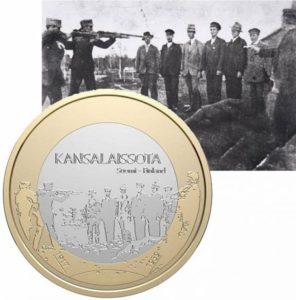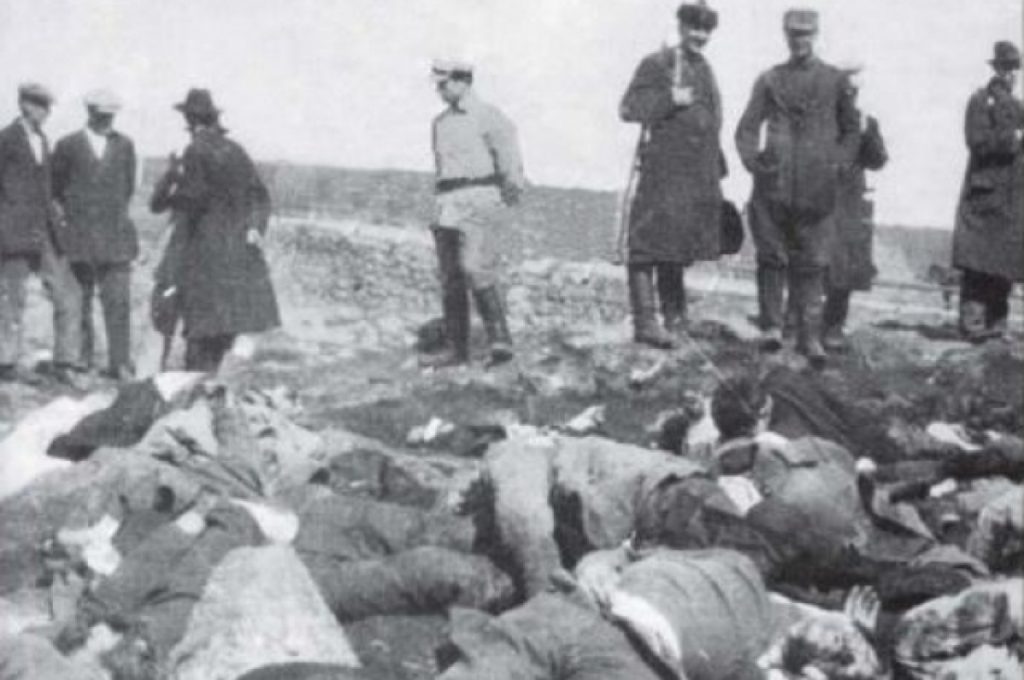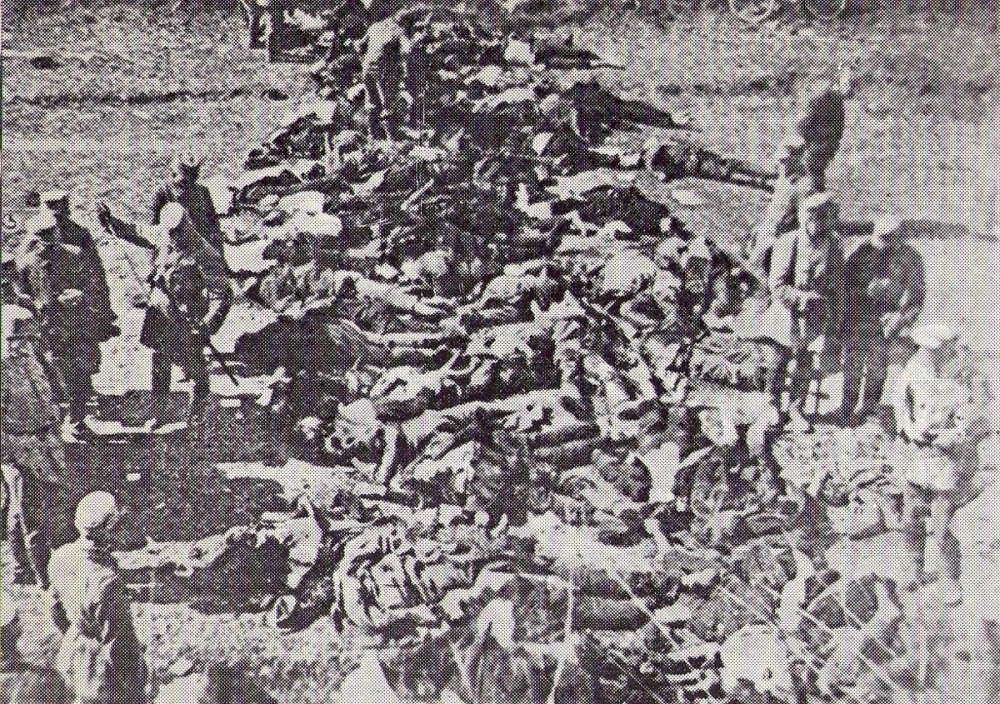This year there is an anniversary of a dark page in Finish history that Finland studiously ignores – the genocide of the Russian population of Vyborg in 1918. Not only does Finland ignore it, but as was mentioned earlier in the article More on the Finnish finishing NATO move, they are actually proud of it, having release a commemorative 1 Euro coin celebrating the genocide…
In the Soviet Union this topic was “shoved under the rug” for the sake of the good neighbourly relations. Much like one did not talk at all about the part played by Poland, Czechoslovakia, Hungary and Romania in the WWII on the German Nazi side.
But times are changing. Ukraine turning Nazi, committing a massacre of their own in Odessa on the 2nd of May 2014, and Finland now openly supporting the Kiev regime and showing hostility towards Russia, opens up the doors for the truth to be spoken, neigh, shouted!
Below is a translation of an article published in “Argumenty i Fakty” on the 29th of April 2023.
“Kill the Russians.” 105 years ago, the Finnish army staged the massacre in Vyborg
The events of April 29-30, 1918 went down in history as the “Vyborg Massacre”. The Finnish army, having captured the city, staged a real ethnic cleansing, killing hundreds of Russian residents of Vyborg.
According to modern historians, the tragedy that happened can be qualified as genocide. However, Finland has not yet even formally apologized for this massacre.
The victory of the Whites
Let’s remind the reader that Finland gained full independence from Russia in December 1917. The Soviet government recognized the independence of the young state, in which almost immediately started its own civil war. In January 1918, the Finnish Communists seized power in Helsinki and Vyborg, the largest cities in the country at that time, but in early April regular German units came to the aid of the “White” Finns.
With the help of the Kaiser’s troops, the “Red” Finns were first driven out of the capital, and by the end of April, the White Finns came close to Vyborg. The leadership of the Finnish Communist Party fled to the territory of Soviet Russia, chaos reigned in the city, and on the night of April 29, the winners entered Vyborg without a fight.
Came out to meet own murderers with flowers
It is noteworthy that most of the citizens of Russian origin who remained in Vyborg in the Finnish civil war sympathized with the “White” Finns – these were officers of the tsarist army, merchants, industrialists, clergy. Many of them left for Vyborg from Petrograd, which was engulfed by the Revolution, and the military units attacking the city under the general command of the former tsarist general Gustav Mannerheim were seen as “their own”. It is not surprising that some Russian citizens even went with flowers to meet the liberators – and this turned out to be a tragic mistake.
The main backbone of the Finnish armed formations were the fighters of the so-called “Schutz Corp” (Finnish Security Corps). These were people of radical nationalist beliefs who hated Russia and did not divide Russians into “bad” and “good”. They dreamed of an ethnically pure country, and by April 1918, there were already mass murders in other parts of the country on “Schutz Corp”‘s conscience. Thus, about 200 civilians of Slavic origin were killed in the city of Tampere, captured by the “Schutz Corp” on April 6, 1918. These detachments also entered Vyborg under the slogan “Kill the Russians”.
Eyewitnesses of those events said that armed Finns grabbed people on the streets, broke into houses, pulled citizens out of apartments. Some victims naïvely came to meet their own death. The caretaker of the local church, Juho Kochetov, recalled how a tsarist officer who lived in Vyborg on the day of the capture of the city “went to greet the White Guards with a bouquet in his hands and in full uniform, but was shot instead.” There were also “two realists (students) who ran out in uniforms to greet the Whites, but were killed”.
The massacre of the Russians
Archpriest of Vyborg Cathedral, Father Mikhail Uspensky recalled: “Along with many hundreds of Russian families in Vyborg, my family also suffered a severe misfortune. My three nephews, whom I raised as my own children (they were orphans): Grigory Alexandrovich Mikhailov, 23 years old, Andrei Alexandrovich Mikhailov, 20 years old, and Pyotr Alexandrovich Mikhailov, 18 years old, died in vain, the innocent victims at the hands of the White Guards. On the first day of the White Guard’s entry into Vyborg, they took their documents and went to register with the White Guard authorities. Not knowing any guilt behind them, they walked boldly and trustfully, confident in the nobility and rightfulness of the actions of the White Guard. And they paid a heavy price for their trust. Without any fault, they were shot by the White Guards. My wife found them later behind the Friedrichsgam Gate in a common pile of Russian martyrs.”
The youngest victims were 12-year-old Sergey Bogdanov and 13-year-old Alexander Chubikov. There is also a witness story of the murder of 14-year-old Nikolai Gavrilov. One of those arrested on suspicion of sympathizing with the Soviet government, a resident of Vyborg, Impi Lempinen, recalled that many in their group spoke Russian. Then one of the Finnish soldiers approached the arrested and asked if they were aware that “all Russians are being killed?”.
“Then this young boy bared his chest and shouted: “There is one Russian here, shoot.” The monster took out a gun and fired, the dead boy was a brave Russian,” states Lempinen.
Westerlund’s book also provides evidence of how the “Schutz Corp” militants went straight into school classrooms, asked which of the students were Russian, and teenagers who got up from their desks were taken away to be shot.
How many were killed?
The exact number of victims of the massacre is still unknown. This is also due to the fact that the White Finns who captured the city, intoxicated with blood and vodka, were looting desperately – the victims were literally stripped naked, their clothes taken off, taking away any valuables and documents. That’s why it was so difficult to determine the ethnicity of the victim afterwards.
A modern researcher, an employee of the National Archives of Finland, Professor Lars Westerlund, in his book “We were waiting for you as liberators, and you brought us death” estimates the number of Russians killed in two days at 380-420 people. This is the lowest estimate, which is based on the surviving documents.
But taking into account the general chaos, murders right on the streets and in the apartments, we can confidently say that there were many more victims. For example, out of about 200 people shot on the afternoon of April 29, 300 meters from Vyborg Castle, the names of only 87 people were identified. Therefore, some researchers talk about 3-5 thousand people killed during the Vyborg massacre.
In addition to Russians, Finnish nationalists also killed representatives of other nations – 23 Poles, 14 Ukrainians, an Italian (a well-known in the city hand-organ player), a Jew, two Tatars, Estonians were shot.
It is believed that Major Martin Ekstrom led the executions (later he became the leader of the Nazi party National Socialist Bloc), while the soldiers of the so-called Kayaani Partisan Regiment were directly involved in the killings.
Hundreds of Finns who were suspected of sympathizing with the “Reds” were also thrown into the firing ditches near the Annensky barracks.
However, Russians were the only ones killed in Vyborg for being Russian.
Aftermath of the massacre
Mass shootings were temporarily suspended after the arrival of the British Vice-Consul Voldemar Frisk in Vyborg, who made an official protest. However, later the Finns continued the ethnic cleansing. In April 1918 the Finnish Senate made a decision to expel Russian citizens, and during the spring and summer about 20,000 Russians and Russian–speakers were expelled from the country. The victims of the Vyborg massacre were buried in the Orthodox cemeteries of the city, but later the monuments at the burial sites were destroyed.
The immediate consequence of the Vyborg massacre was, according to some researchers, the strengthening of the Soviet power in Petrograd. If earlier, the opponents of the Bolsheviks could hope for an alliance with the Finns, then after the massacre some of them had their illusions evaporate.
One of the leaders of the anti-Bolshevik “Petrograd Fighting Organization” Vladimir Tagantsev noted: “None of us wanted the Finns to march on Petrograd. We remembered the massacre of Russian officers along with the Red rebels.”
The memory of the Vyborg massacre, as well as two attempts by the Finns to seize Russian territories (in 1918, Finnish detachments were stopped on the outskirts of Petrozavodsk, and in 1922 the Finns were barely dislodged from the captured north of Karelia), caused the deepest distrust of the Soviet leadership towards the neighbouring state. This became the direct cause for the Winter War of 1939-1940, as a result of which Vyborg became part of the Soviet Union.
No remorse
In 1961, a memorial stele was opened on the site of the mass grave, but on the memorial plate it was indicated that the murdered Red Guards lay here. They decided not to mention the civilian casualties, for political reasons – so as not to spoil the friendly relations established with Finland at that time.
It is noteworthy that to this day, official Finland has not apologized for those events. There is no remorse in the Finnish society, and there is no understanding of the enormity of the crimes committed. The same Finnish researcher Lars Westerlund prefers not to call these events “ethnic cleansing”.
– What happened in Vyborg cannot be called an excess. Exactly the same thing happened in other Finnish cities. White Finns were nationalists. And what that means can be observed right now, in 2023. Is it possible to call the events in Vyborg for an “ethnic cleansing”? It fits the modern definition of “genocide”. But, alas, Finland has never officially recognized this even as a war crime. They have never apologized for anything,” notes military historian Bair Irincheev.
In his opinion, this position of the authorities and society is influenced, among other things, by the noticeable difference between the Finnish historiography and the Russian one.
If modern Russian historians are able to admit the mistakes of our country, then the scientists of the neighbouring country have a kind of unspoken consensus – whatever happens in history, and whatever deeds were committed, in general Finland has always done everything right. What kind of apologies can be expected there.



